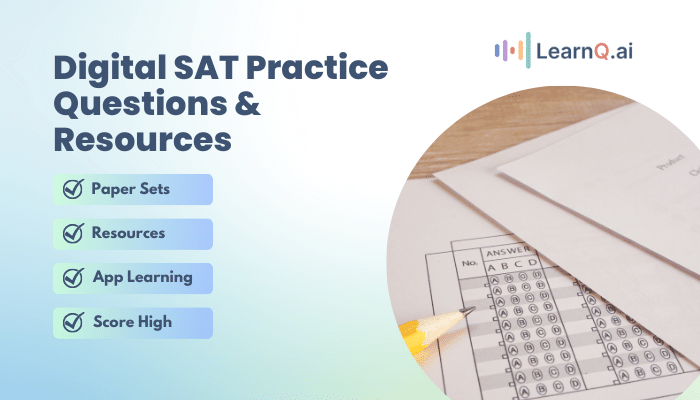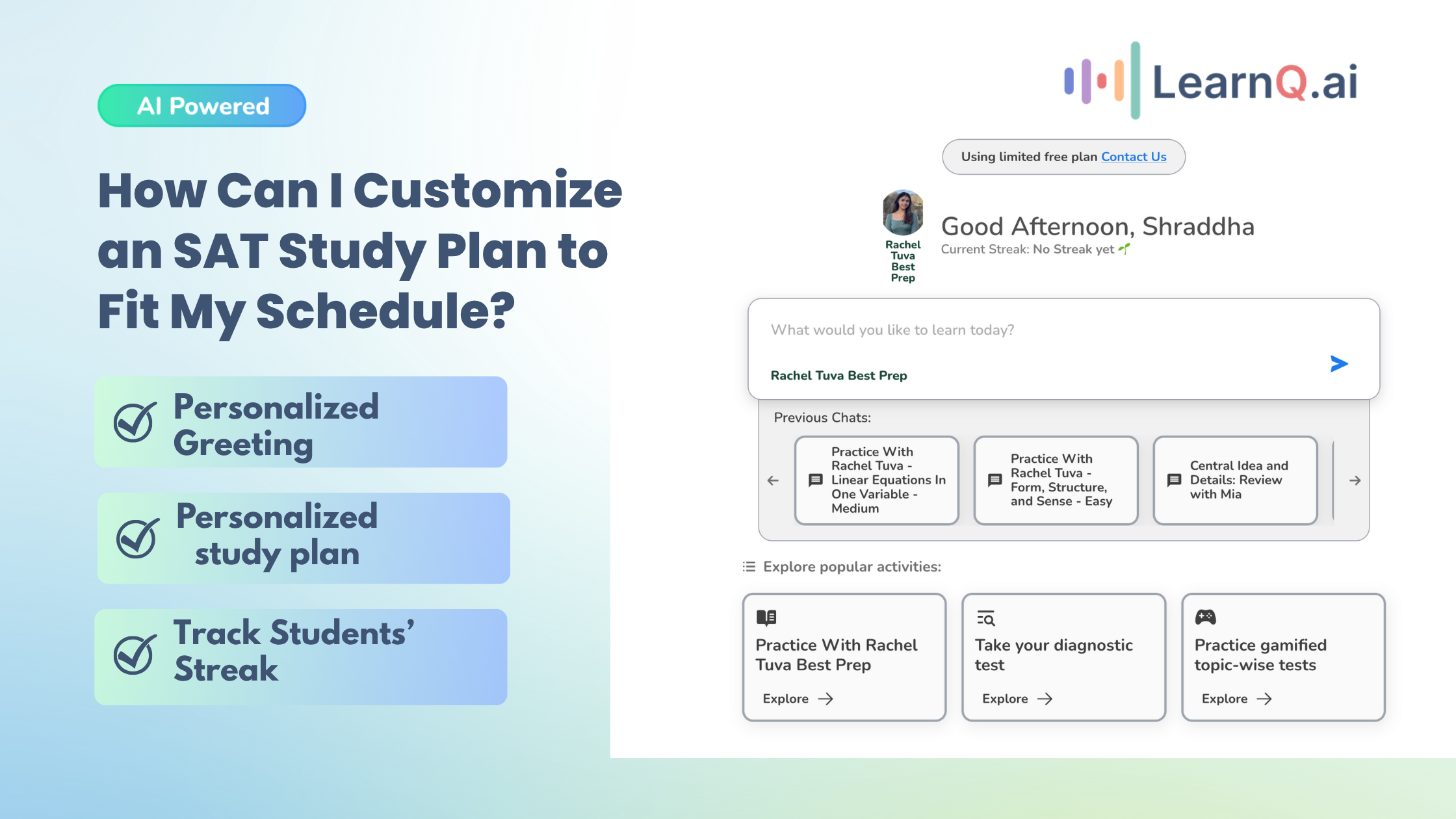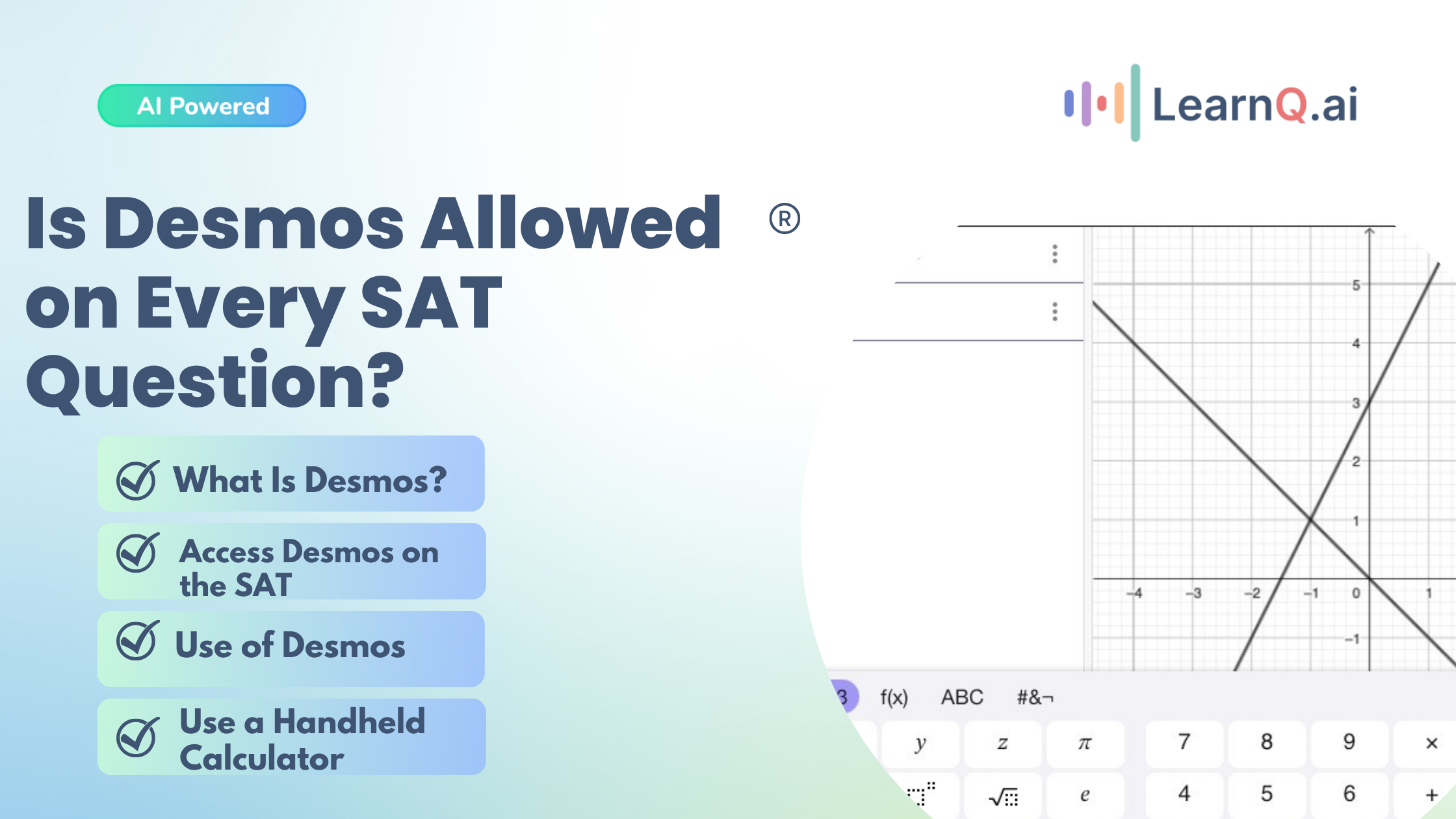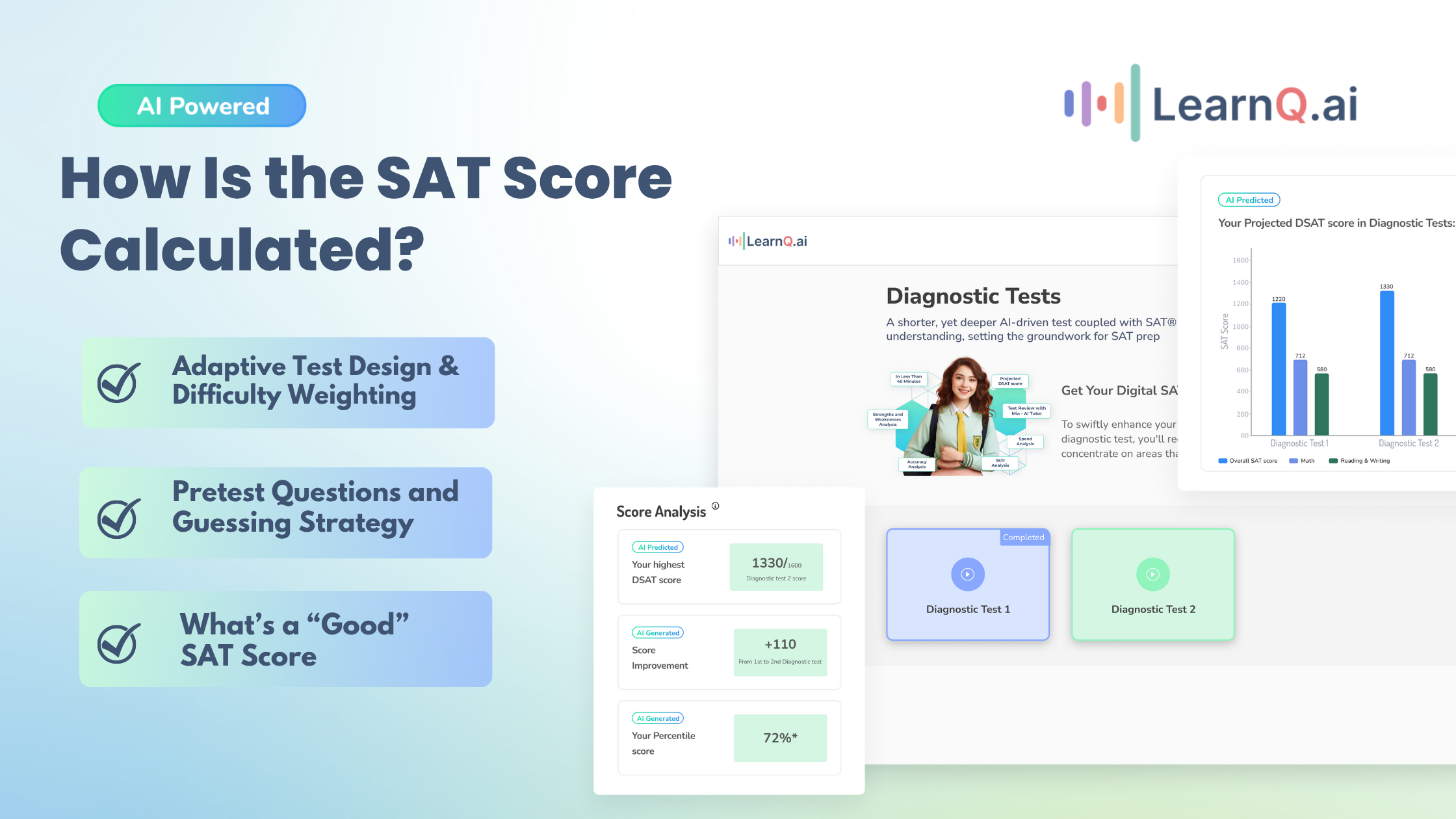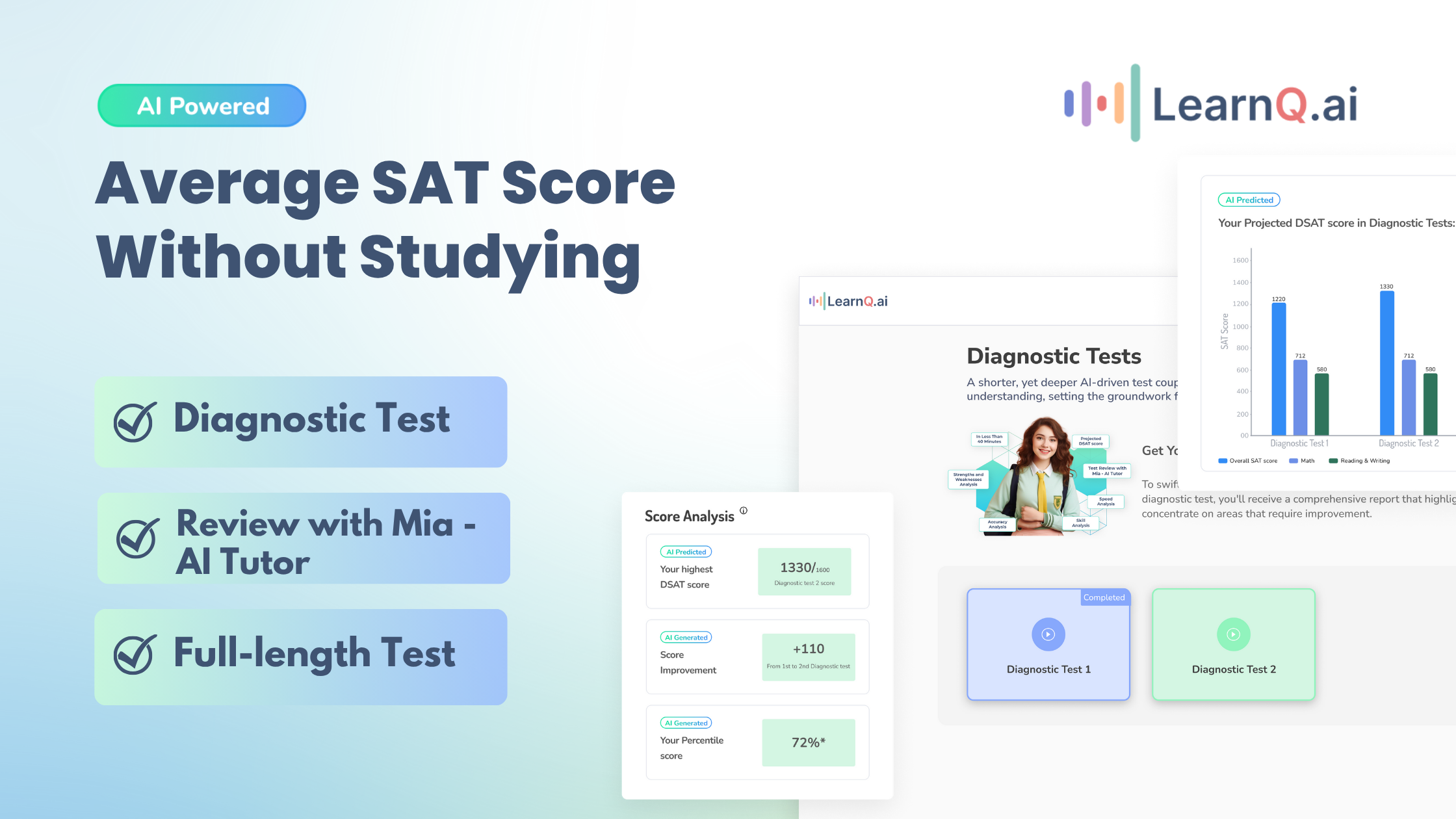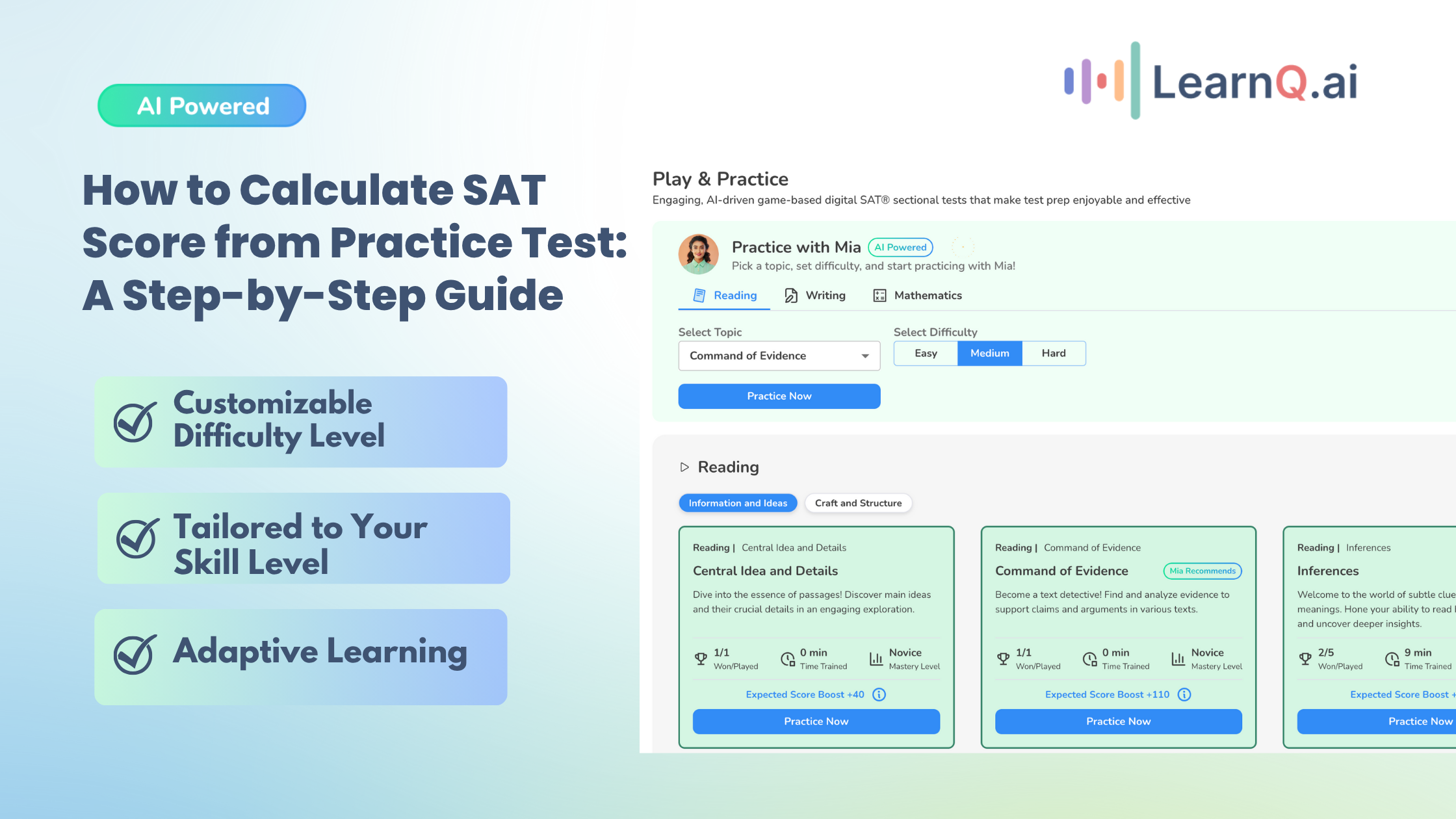Who doesn’t love a road trip? We all do! But whenever you take a road trip to a place you’ve never visited, you don’t just jump in the car without looking at a map, right? That’s pretty much the case with Digital SAT.
SAT practice questions are akin to the map that ensures you reach your destination! Practicing for the Digital SAT is crucial because it will give you an idea about the type of questions you’ll face, the format they’ll come in, and the best strategies to tackle them. The more familiar you are, the more confident you’ll feel on test day.
Now, you might wonder, “Where’s the best place to find SAT Practice Questions?” In that case, we have a little secret we want to spill: not all practice materials are created equal.
Only those questions that mirror the official SAT questions are gold. Why – you ask us? Well, that’s because these questions:
- Are developed by the same people who make the actual test. Solving them ensures you’re solving SAT practice questions that closely mirror what you’ll see on test day
- Offer detailed explanations for answers, helping you understand your mistakes and learn from them
- Provide a personalized practice experience, adjusting to your strengths and weaknesses
Now, let’s get into the meat of the matter—the Digital SAT format. If you’ve been wondering what the test will look like, we’ve got you covered.
Digital SAT is divided into the following sections:
- Reading and writing: You’re looking at passages that reflect real-world scenarios. You’ll need to analyze them, interpret data, and understand how arguments are constructed. You will have 64 minutes for this section, split into two modules
- Math: This part tests your number-crunching skills in real-life situations. You’ve got two segments here. Together, you will get 70 minutes to show off your math skills, also divided into two modules
Also Read: SAT Exam Goes Digital, Here’s What You Need to Know
Getting Started with SAT Practice
Stepping into SAT preparation might feel like gearing up for a big adventure. It’s okay to feel a mix of excitement and nervousness but remember, with the right tools and a solid plan, you’re going to do great.
Every step you take is a step closer to your dream college or university. So, let’s discuss how to start off on the right foot.
Introduction to the Bluebook App for SAT Practice
Imagine having a personal SAT coach with the most significant SAT practice questions available anytime, right in your pocket. That’s what the College Board’s Bluebook app is like.
It’s your go-to for practicing SAT questions in a way that mimics the real digital test environment. Here’s what you need to know:
- Real SAT questions: Many SAT practice questions in the Bluebook are those questions that have actually appeared on past SAT exams
- Instant feedback: Answer SAT practice questions, and the app tells you right away if you got them right or where you went astray. It’s like having a tutor who gives you instant pointers
- Custom practice tests: The app allows you to create practice tests tailored to your study needs. More focus on math? Done. More reading practice? You got it
Integrating SAT practice questions from the Bluebook into your study routine means you’re learning the ins and outs of the test format firsthand. Now imagine, if you could take this material to the next level with the help of AI analytics and gamification? That’s what LearnQ.ai does for you!
Setting a Target Score for the SAT
Now, let’s talk about goals. Setting a target SAT score might seem daunting, but it’s like setting the destination on your GPS before you start driving. Still, you can’t shoot random numbers out of thin air. The goal is to be realistic, and here’s how you can do it wisely:
- Research your dream schools: Look up the average SAT scores for incoming freshmen at the colleges you’re eyeing. This gives you a ballpark figure to aim for
- Assess your starting point: Practice hard with SAT practice questions and then take a diagnostic test to see where you stand. Comparing this to your dream schools’ averages helps you set a realistic goal
- Plan your study time: Your target score helps determine how much time and effort you need to invest. The bigger the gap from where you are to where you need to be, the more SAT practice questions you should tackle
Feeling overwhelmed by where to start? LearnQ.ai’s Diagnostic Tests can help you identify your starting point effortlessly by giving you the test scores within 40 minutes.
LearnQ.ai is Powered by VEGA AI—Is your Institute Next?
Give students a Duolingo-style test-prep platform with Shopify-level customization for tutors and institutes.
Practice Tests and Resources
As you get deeper into your SAT preparation, remember that practice tests are like rehearsal dinners before the wedding. They’re your chance to get used to the spotlight, so to speak, before the day of the test.
So, what are you waiting for? Tag along and learn how to tap into a vast pool of SAT practice questions and more!
Availability of Full-length Practice Tests
The College Board’s Bluebook app is a treasure chest full of SAT practice questions, mirroring the examination questions. And so is LearnQ.ai. With a bank of over 10,000 SAT practice questions at your disposal and a highly intellectual AI tutor, Mia, when you weave our offerings with the Bluebook, you’re setting yourself up for nothin but success!
Here’s why: Our full-length mock tests and sectional tests mirror the actual SAT in format, timing, and content, providing a realistic test-taking experience!
Resources for Students with Disabilities
The College Board is committed to making SAT preparation accessible to everyone. So, if you have a disability, here’s all the help available for you:
- PDF practice tests: For students who require screen reading technology, PDF versions of SAT practice questions and tests are available
- Braille and large print: Braille and large-print exam materials are also offered to ensure that every student can prepare for the SAT comfortably and effectively
But that’s not all. If you have a disability, you will also be entitled to tailored accommodations, including:
- Extended time & breaks
- Reading and seeing options like text-to-speech technology
- Recording answers through a writer/scribe or a braille writer
- Testing in a small group or ensuring wheelchair accessibility
Advantages of Using Practice Tests for Preparation
Incorporating full-length practice tests apart from quick SAT practice questions into your study routine has several benefits. We’ve compiled the best ones below. Have a look!
- Familiarity: The more tests you’ll practice, the more familiar you become with the test’s format and types of questions, reducing test-day anxiety
- Time management: Practice tests help you gauge how much time to spend on each section, improving your time management skills
- Identify weaknesses: Regular practice allows you to identify areas where you need improvement, focusing your study efforts more effectively
How to Access the SAT Suite Question Bank?
Let’s address the elephant in the room now – yes, there’s a much-hyped SAT Suite Question Bank with invaluable SAT practice questions provided by the board, but how do you access them? If you’ve been thinking about it, here’s all the information you will ever need:
- Visit the College Board website: The Question Bank is part of the suite of tools offered for SAT prep
- Customize your practice: You can filter questions by difficulty, type, and content area, allowing you to focus on particular skills or challenges
- Integration with prep tools: Use the Question Bank in tandem with the Bluebook app and other preparation resources for a well-rounded preparation strategy
Studying and Practicing for the Digital SAT
The journey to conquering the Digital SAT requires a strategic approach. And the right strategy is to use the right SAT practice questions, take a lot of practice tests, and follow time-management techniques.
But that’s not all! We have other great proven tips that have helped hundreds and thousands of students taking up the Digital SAT examination. So buckle up, and you’ll be ready to take the examination head-on in no time!
General Tips on Preparing for the Digital SAT
Mastering the Digital SAT starts with a solid foundation. Here’s how you should build yours:
- Understand the digital interface: Spend time getting comfortable with the digital format. This means practicing on the device you’ll use on test day, familiarizing yourself with how to answer questions, and navigating through sections
- Identify your learning style: Whether you’re a visual learner, prefer reading/writing, or learn best through kinesthetic means (hands-on activities), tailoring your study approach to fit your style can enhance your retention and understanding
- Practice mindfulness and stress-management techniques: Preparing for the SAT isn’t just about academic readiness but also mental preparedness. Incorporate mindfulness exercises, such as meditation or deep-breathing techniques, into your routine to manage test anxiety and improve focus
Integrate LearnQ.ai’s Play & Practice questions into your study routine for a personalized journey, tailored to your strengths and weaknesses.
How to Effectively Use Official Practice Resources?
- Blueprint of official SAT practice: Start by creating a personalized study plan which syncs with your previous SAT scores if you’ve taken one before. This targeted approach ensures you’re focusing on areas that will most impact your score
- Incorporate a variety of SAT practice questions: Make sure your practice covers a wide range of question types you’ll encounter on the test, including those that test your critical thinking, problem-solving, and data analysis skills
- Regular, timed practice sections: To mimic testing conditions, regularly complete practice sections under timed conditions. This will help you build stamina and improve your time management skills, ensuring you can complete sections within the allotted time on test day
Take Practice Exams, View Results, and Review Answers Through My Practice
Other than taking full-length practice tests on LearnQ.ai’s platform, you also have a wealth of information that you can access through the The My Practice feature on the College Board website. You must use that material too – the more, the merrier!
Here’s a step-by-step guidance on what to do:
- Create an account on the College Board website if you haven’t already done so
- Upon accessing My Practice, you’ll find a dashboard serving as your SAT preparation command center. The dashboard provides a comprehensive overview of your practice activity, including your progress on practice tests
- Take practice exams to enhance your time management skills further
- After completing a practice exam, you’ll receive immediate feedback. This includes a detailed breakdown of your results by section and question type, allowing you to pinpoint specific areas for improvement
Engaging With Your Results
Understanding how to interpret and act on your results is key to finally attaining the goal you have set for yourself. So,
- Look for patterns in the types of SAT practice questions you find challenging
- Use the insights from your practice exams to refine your study plan. If you notice significant improvement in one area but not in another, allocate more study time to the latter
Timeline for SAT Preparation
Steps for Preparing from the Moment of Decision to Test Day
Preparing for the SAT isn’t just about practicing SAT practice questions or taking mock tests. There’s a lot more to it. Considering you’re about to take up one of the most challenging examinations in the world and how overwhelming it can be, we’ve broken down the journey for you. Have a look!
Initial Preparation Steps
- Choosing your test date: Ideally, start your SAT preparation at least 3 to 6 months before your chosen test date
- Creating a study plan: Assess your initial skills with a diagnostic test to understand your baseline. Based on your results, create a study plan that allocates more time to areas that need improvement. Incorporate daily and weekly goals to keep your preparation on track
- Set up your study space: Create a dedicated, distraction-free study area. Having a specific place to study can help condition your brain for focused study sessions
- Incorporate reading into your daily routine: Beyond SAT practice questions, read widely from various sources—newspapers, journals, fiction, and non-fiction. This will help improve your reading comprehension skills
- Familiarize yourself with the digital interface: Early in your preparation, take the time to explore the digital testing platform. Pay special attention to navigation features, how to mark questions for review, and the on-screen calculator for the Math section. Knowing how to use these tools efficiently can save precious time during the test
- Practice writing and language skills: Engage in writing exercises focusing on grammar, usage, and clarity. Consider journaling or blogging as a way to hone your writing skills
Pivot when you’re Midway Through
- Engage with SAT practice questions: Regularly solve SAT practice questions to familiarize yourself with the question types and formats
- Simulate test conditions: After about a month of consistent study, begin taking full-length practice tests provided by LearnQ.ai under timed conditions. Aim to complete a practice test every two weeks
- Start leveraging interactive features like graphs and charts: The Digital SAT often includes questions that involve interpreting data from graphs and charts. Use online resources to practice reading and analyzing these visual data representations
- Use highlighting and note-taking features: Practice using digital tools such as highlighting and note-taking features. These can help you quickly identify key information in passages or note down important formulas in math questions
- Practice with the on-screen calculator: Get comfortable with the on-screen calculator provided during the Math section. Familiarize yourself with its layout and functions by using a similar calculator during your study sessions
Final Nail to the Coffin
- Review and refine: In the last month leading up to the test, focus on refining your skills and knowledge. Continue to work on SAT practice questions, paying particular attention to areas where you’re still facing challenges
- Mental preparation: Reduce test day anxiety by practicing relaxation techniques. Confidence and a positive mindset can significantly impact your performance
Important Milestones
Completing Exam Setup
A few days before your test, complete any required setup. This might include verifying your test center location, ensuring your testing device meets the necessary specifications, and downloading any required software.
Enhance your Digital SAT study routine with AI-driven insights and personalized practice tests.
What to Do on Test Day
- Arriving on time: Plan to arrive at the test center at least 30-45 minutes early. This gives you enough time to find your testing room, settle in, and calm any last-minute nerves. Late arrivals might not be admitted
- Checking the admission ticket: Before leaving home, double-check that you have your admission ticket and acceptable photo ID
- During the test: Manage your time wisely, and don’t spend too long on any one question. Remember, it’s okay to guess if you’re unsure — there’s no penalty for wrong answers in digital SAT
Preparation Guides and Tips for Test Day
This section is meticulously designed for U.S. and international students, as well as parents and guardians seeking to support their child’s SAT journey effectively. Let’s get you started!
SAT Student Guide for U.S. and International Students – Preparation Tips
Begin by familiarizing yourself with the digital format’s layout and functionality.
- Explore the custom-built digital testing application, noting how it’s designed to enhance the test-taking experience
- Pay special attention to the “Mark for review” feature, allowing you to flag questions for later review within each module, and the built-in graphing calculator available throughout the Math section
Then, move on to the Adaptive Test Design. The Digital SAT introduces a two-stage adaptive test design.
Grasping how your performance on the first module influences the difficulty of the second module can help you approach the test more strategically. Utilize SAT practice questions and practice tests to experience this adaptive nature firsthand, adjusting your test-taking strategies accordingly.
For International Students
Enhance your English language proficiency by immersing yourself in a variety of English media sources, including:
- Books
- Scholarly articles
- Podcasts and news outlets
This exposure will broaden your vocabulary, improve your reading comprehension, and familiarize you with idiomatic and formal English usage.
Tackling SAT practice questions daily, especially in reading comprehension and writing, is also essential for adapting to the exam’s language demands.
Even the board offers additional help to English Learners (ELs) in the following ways:
- Translated test directions & bilingual dictionaries: To aid comprehension and ease test-day anxiety, EL students can access translated test directions and use bilingual word-to-word dictionaries during the exam
- Extended testing time: Recognizing the additional challenge of taking a test in a second language, EL students are afforded time and one-half (+50%) extended testing time
Advice for Parents/Guardians on Supporting Their Child’s SAT Practice
Support from parents goes beyond moral encouragement; it involves creating a physical environment conducive to focused study. This means providing a quiet, well-lit study area, free from distractions. Respect this space and time, ensuring your child can study undisturbed.
While it’s important to motivate and believe in your child’s potential, it’s vital to balance encouragement with realistic expectations.
- Celebrate progress and effort, not just high scores
- Understand that improvement often comes in waves and that each student faces unique challenges
- Be attentive to the emotional and physical well-being of your child
- Encourage healthy study breaks, proper nutrition, and sufficient rest
- Recognize signs of burnout or test anxiety and discuss strategies to manage these feelings
- Offer the child access to a support counselor in case of extreme stress
Timing
Navigating the timing for the digital SAT requires a strategic understanding of its adaptive format and the specific allocation of time for each section. This section aims to provide a comprehensive explanation on managing the digital SAT’s unique structure.
Guidance on Taking the Full-Length Linear (Nonadaptive) SAT Practice Tests
- Adapting practice for an adaptive format: While the digital SAT adapts between modules based on performance, practicing with linear tests can help build endurance and familiarity with a range of question difficulties. Use these tests to gauge your timing across sections, noting that the actual test may adjust in difficulty dynamically
- Simulating the digital experience: Although full-length practice tests are linear, aim to simulate the digital testing environment by practicing with online platforms that mimic the test’s interface, including the use of digital tools such as on-screen calculators and timers
Component-wise Time Allotted for Reading and Writing and Math Sections
Reading and Writing Section
The Reading and Writing section adopts a two-stage adaptive format consisting of two modules with a total time of 64 minutes. Each Module:
- Contains 25 operational questions and 2 pretest questions, with 32 minutes allotted per module
- This section tests skills through discrete, four-option multiple-choice questions covering literature, history/social studies, humanities, and science topics, including informational graphics like tables, bar graphs, and line graphs
Math Section
The Math section is structured in a two-stage adaptive format, divided into two modules with a total time of 70 minutes. Each module:
- Features 20 operational questions and 2 pretest questions, with 35 minutes designated for each module
- Questions are presented as discrete, four-option multiple-choice (approximately 75%) and student-produced response (SPR) types (approximately 25%), focusing on science, social science, and real-world topics, along with informational graphics
Strategies for Effective Timing
- Pacing practice: Given the sectional timings, practice pacing yourself to ensure you’re comfortable handling the number of questions within the allotted time
- Module-specific strategies: Develop strategies for each module, considering the adaptive nature of the test. Focus on maintaining a steady pace in the first module to set a strong foundation for the second, more tailored module
- Utilizing breaks wisely: There’s a 10-minute break between the Reading and Writing sections and the Math sections. Use this time to mentally reset and prepare for the shift in focus from verbal to quantitative reasoning
Additional Resources and Downloads
Preparing for the SAT is a journey, and on this path, you’ve got a variety of SAT practice questions and multiple other resources at your fingertips. Let’s explore how you can use these tools to your advantage.
Availability of SAT Practice Essays and Score Explanations
Practice Essays for the Digital SAT
- Did you know you can practice writing essays even for the digital SAT? While essays are no longer a part of the SAT, practicing with them can sharpen your analytical, writing, and critical thinking skills, which are crucial for the Reading and Writing section
- You can find digital practice essays online. These are great for getting a feel of what writing under timed conditions is like
Score Explanations to Guide Your Learning
- Alongside practice essays, you’ll find detailed score explanations. These aren’t just about giving you a score; they break down why an essay received the score it did. This feedback is golden! It helps you understand what examiners look for and how you can improve your writing to score higher

Downloadable Full-length Linear (non-adaptive) SAT Practice Tests (1-4)
SAT Practice Test 1
Often considered the introductory practice test, Test 1 is designed to familiarize you with the SAT format and question types. It’s balanced in terms of difficulty across sections and serves as a benchmark to gauge your initial readiness.
Use this test to get a feel for the timing of each section. Don’t worry too much about your score; focus on understanding the types of SAT practice questions and identifying areas for improvement.
SAT Practice Test 2
This test ramps up slightly in difficulty, with a mix of straightforward and more challenging questions, especially in the Math section. It’s a good measure of your progress after some initial study and review.
Pay special attention to time management with this test. Challenge yourself to finish each section with a few minutes to spare for review. After completing the test, spend extra time on the SAT practice questions you found challenging, dissecting why you found them difficult and how you can approach similar questions in the future.
SAT Practice Test 3
Test 3 is notable for its diversity in passage topics in the Reading section and a good mix of algebraic and geometric concepts in the Math section. It’s a comprehensive test that can help identify your strong and weak academic areas.
- Use this test to practice active reading strategies for the Reading section, such as noting key points and summarizing paragraphs
- For Math, focus on applying conceptual knowledge to solve problems efficiently
Reviewing this test thoroughly can provide deep insights into your problem-solving approach and reading comprehension skills.
SAT Practice Test 4
Often considered more challenging, especially in the Reading and Writing section, Test 4 offers complex passages that require careful analysis and interpretation. The Math section continues to test a broad range of topics, with an emphasis on applying mathematical concepts in varied contexts.
This test is great for practicing endurance and maintaining focus through more difficult sections. Approach it with a mindset of pushing your limits.
- For the Reading section, concentrate on refining your strategies for tackling complex passages and questions
- In Math, focus on precision and the application of multiple steps to solve problems
How to Use These Tests
- Set aside time to take these tests as if you were sitting for the actual SAT. Find a quiet spot, time yourself, and resist the urge to pause. This simulates test day conditions and helps build your test-taking stamina
- Review your answers after taking a test, especially the ones you got wrong. The beauty of these practice tests on LearnQ.ai is not just in taking them but in learning from them. Dive into the explanations for each answer, understanding why the correct answers are right and why the incorrect ones are wrong. This reflection and review process is where your learning deepens and your scores start to climb
LearnQ.ai is powered by VEGA AI—Is your institute next?
Offer students a Duolingo-style test-prep platform with Shopify-level customization for tutors and institutes.






Conclusion
“The journey of a thousand miles begins with a single step. Watch your step.”
Lao Tsu
Clearing the Digital SAT is not a sprint; it’s a whole journey. And the entire journey starts with knowing which materials will eventually help you succeed and where to find them! By getting familiar with the format and practicing the right SAT practice questions, you’re setting yourself up for success.
Whether you are trying to build a study timeline or trying to include SAT practice questions in your daily study routine, incorporate LearnQ.ai’s structured learning paths to ensure no topic is left untouched, and you’re advancing at the right pace.
And hey, it’s totally okay to feel a bit nervous. Just remember, preparation is your best friend here. Familiarize yourself with built-in tools, and take as many full length practice tests before appearing for the final examinations as you can. We can be your wingman to assist you on your journey to becoming a great scholar!

